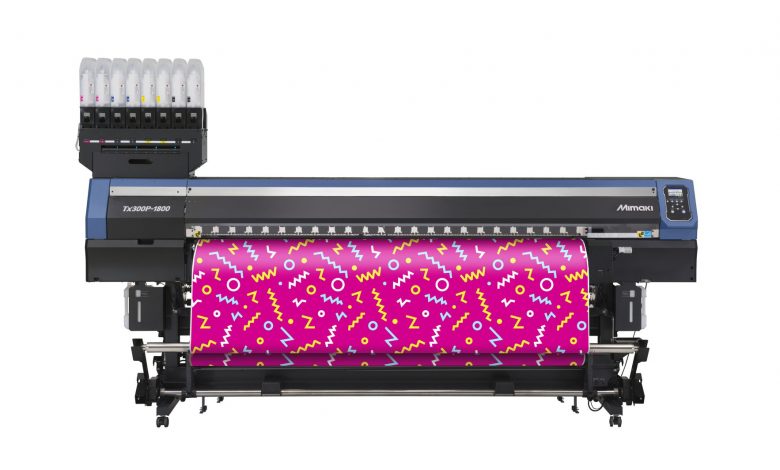Dye-Sublimation vs. Direct-to-Substrate: To Heat Transfer or Direct-Print?
The ease and versatility of the transfer process gives it a distinctive edge
No matter how popular direct-to-textile printing becomes, it’s likely dye-sublimation using transfer paper will remain king in the industry. The biggest reason for that is transfer paper can be used on just about any surface, not just textiles.
The transfer process offers better “fine line and detail and image quality vs. a coated textile where you are able to lay more ink down,” says Victoria Harris, application specialist, Mimaki USA. “In direct-to-textile, you are able to absorb more ink. Where it is important to have high saturation and good bleed-through to the reverse side of the fabric, this is a more desirable process.”
She points out that flags and certain fashion applications work better with direct-to-textile printing.
“When looking at the transfer process, you don’t have to have coated fabric. You can select any textile you want as long as it is polyester,” says Harris. “Also with the transfer process, you are able to do rigid substrates that are polyester coated. Because image quality with the transfer process has better detail because the amount of ink going onto the substrate is more controlled, it is (better) for things viewed up close.”
David Lopez, textile solutions specialist/business development for Mimaki, says that he always tells customers that paper transfer is more versatile. Mimaki’s direct-to-textile printer is geared more toward the flag business where you want the design to bleed through to the other side.
“Sometimes I have customers come up to me who want to do direct-to-fabric so they don’t have to purchase paper,” he says. They believe it will be a huge cost-savings for them. “What they don’t realize, with our system, is you can’t print to polyester without pretreating. There is still an added cost to pretreat.”
If shops want to source 10′ pretreated fabric, it isn’t the easiest to find in the U.S. There are only a couple of textile companies that offer pretreated fabric in that size. There are many more options with paper transfer because a shop can purchase any polyester fabric.
“Being able to do it yourself is going to cut costs and control what goes into these pretreatments,” says Lopez. “Every ink company manufactures ink differently. Pretreatment is not one solution for all.”
He adds that “you get better clarity with paper transfer and better penetration with direct-to-fabric.”
Randy Anderson, product marketing manager for textiles, Mutoh America, says, “Paper is universal. You can use paper across the board, not only for fabrics but garments and hard surface devices as well. It is extremely universal across the board. Direct-to-textile is much more limited. To print on stretch materials, you need a sticky belt to hold the material flat and rigid so you can print on it. That means the material must be coated to be receptive. When you print on fabric, the liquid will wick along the fibers. If you use a pretreatment, it helps control the dots.”
The home décor market is driving direct-to-print, Anderson says, but more than 90 percent is still paper transfer. Direct-to-textile is where dye-sublimation was 10 years ago, he says. “Everything was still up in the air. The inks were changing, the paper was changing. Now there are hundreds of thousands of polyester fabrics and dozens of highly rated inks and papers as well. The dye-sub market is stable and all of its applications are open for just about anybody who can purchase a machine.”
The quilting market is driving a lot of business to direct-to-textile. Anderson says that one of Mutoh America’s clients, Spoonflower, an online custom-printed fabric company, allows people to submit a design and get as much or as little fabric as they want, down to a quarter of a yard.
“So a lot of people will start and buy fabric there to start a business. Once their quantities get to a point where it makes sense to bring that in house, they will buy equipment and start producing their own fabrics,” Anderson says. “They had 28 of our printers there. They’ve since gone to larger and faster printers because volumes increased so much. They still have a half dozen of our printers there for specialty items.”
Clients also use Mutoh machines to print wall coverings and clothing. The company is trying to get some people involved in automotive to do seat covers and headliners, which are more personalized products that a smaller printer would be a good fit for, he adds.
Direct-to-fabric is also used heavily in P.O.P. signage, trade show graphics, museum fine art prints, banners, flags, fabrics for custom clothing and interior design.
Jason Bartusick, product development, strategic planning, Media One USA, says that along with flags, backlit graphics are a good use of direct-to-textile dye-sublimation because “dye-sub backlits have better saturation than they do with transfer.”
A benefit of using transfer paper is that if you have a problem with the machine printing the paper, sublimating can hide the problems.
When people bring up the cost differences of transfer paper vs. direct-to-textile printing, he says that transfer paper costs anywhere from 5 cents to 12 cents per square foot depending on the weight of the paper. On the direct side, it costs about 1.5 cents extra per square foot for a direct disperse coating, he says.
“A lot of people get this perception that coated fabric is super expensive, but everyone is already using coated fabrics. That’s the funny part,” he says. “Everybody is using coated fabrics. Everybody. There is not a single customer in the industry that uses a fabric that is not fire retardant.”
So it doesn’t take that much time to add one more chemical to the textiles before printing direct, he adds.
“From a quality perspective, I’d say transfer is going to give you a little tighter image and just a little tighter on text,” he says, although the difference is so minute he doesn’t think it really matters.
Any material that touches your skin should be done with transfer paper, he adds. If the large print is going to be outdoors, direct-to-textile has better durability than transfer paper.
Another advantage of using transfer paper is that you can do smaller runs, Bartusick says.
As for the cost of the machines, he says they are equivalent. If a shop has never done textile printing before, he says it is a three- to six-month learning curve. He also recommends that shops seek out a good company to help them with the finishing process, like sewing or welding.









